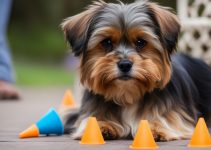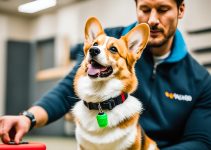I have always had a soft spot for Portuguese Water Dogs. Their intelligence and energy make them incredible companions, but it’s important to remember that they can also be a bit stubborn and nippy at times. That’s why Portuguese Water Dog Training is crucial for these amazing dogs. Whether you have a puppy or an adult Portuguese Water Dog, here are some expert tips to help you train them effectively.
Unravel Portuguese Water Dog Training
- Establish yourself as a strong leader and earn your dog’s respect.
- Consistently use command words and hand signals to reinforce obedience.
- Repetition is crucial as Portuguese Water Dogs are eager to please.
- Set clear boundaries and use positive reinforcement for desired behavior.
- Consider crate training and sticking to a schedule for effective training.
Establishing Leadership
Portuguese Water Dogs are intelligent and independent, but they need a strong leader to guide them. By establishing yourself as the leader, you can effectively train your Portuguese Water Dog and prevent behavioral issues. Here are some key techniques to help you establish leadership:
- Make eye contact: Maintain direct eye contact with your dog to establish dominance and let them know you are in charge.
- Stand over them: Physically position yourself above your dog to assert your authority and establish your dominance.
- Use firm movements and strong actions: Your body language should be confident and assertive, reinforcing your role as the pack leader.

A strong leader inspires trust and respect in their Portuguese Water Dog. When your dog trusts and respects you, they are more likely to listen and follow your commands. Remember to be consistent and patient in your training efforts. With your firm and confident leadership, your Portuguese Water Dog will become a well-behaved and obedient companion.
Command Training
Portuguese Water Dogs are highly intelligent and have the capacity to learn a wide range of words and commands. When training your Portuguese Water Dog, it’s important to start using command words from the beginning and to be consistent in your wording. By repeating commands and combining them with hand signals, you can help your dog understand and respond effectively.
Portuguese Water Dogs are eager to please their owners, making positive reinforcement training highly effective. Use treats and affection to reward good behavior and ignore or redirect unwanted behavior. Consistency and repetition are key in their training, as it helps reinforce learned commands and behaviors.
Here are some tips for successful command for Portuguese Water Dog Training:
- Use clear and concise command words, such as “sit,” “stay,” and “come.”
- Combine verbal commands with consistent hand signals to enhance understanding.
- Practice commands in various environments to generalize the behavior.
- Keep training sessions short and frequent to maintain focus and prevent burnout.
- Use positive reinforcement, such as treats, praise, and play, to reward desired behaviors.
- Ignore or redirect unwanted behaviors instead of using punishment.
Remember, patience and consistency are key in Portuguese Water Dog Training. With dedication and positive reinforcement, your furry companion will become well-behaved and obedient.
Setting Boundaries
When it comes to Portuguese Water Dog Training, setting clear boundaries is key. These intelligent and energetic dogs thrive when they know what is expected of them. By establishing rules and enforcing them consistently, you can help your Portuguese Water Dog understand what behavior is acceptable and what is not.
One important aspect of setting boundaries is addressing unwanted behaviors such as jumping or begging. Be firm and consistent in your expectations, and use positive reinforcement to redirect your dog’s attention to more appropriate behaviors. By rewarding good behavior and ignoring bad behavior, you can effectively shape your Portuguese Water Dog’s behavior and encourage them to make better choices.
While it’s important to be firm, it’s equally important to avoid using negative reinforcement. Punishing or scolding your dog can be counterproductive and may damage the bond of trust between you. Instead, focus on positive reinforcement by using treats, praise, and rewards to reinforce desired behaviors.
If you’re uncertain about how to effectively set boundaries or need additional guidance, consider enrolling your Portuguese Water Dog in professional training classes. These classes offer structured environments where your dog can learn and practice appropriate behaviors under the guidance of experienced trainers. They also provide opportunities for puppy socialization, which is crucial for their development.
Remember, consistency is key in setting boundaries. By establishing clear rules, using positive reinforcement, and seeking professional guidance when needed, you can create a harmonious and well-behaved bond with your Portuguese Water Dog. Now let’s move on to the next section to learn about crate training and establishing a schedule.

Crate Training and Schedule
Crate training is a valuable tool in the training of Portuguese Water Dogs. It provides them with a safe and comfortable space while aiding in house training. By using a crate consistently and adhering to a schedule, you can effectively train your dog and prevent destructive behavior.
Benefits of Crate Training
Crate training is particularly beneficial for puppies. It helps them develop a sense of security and prevents them from engaging in unwanted behaviors when unsupervised. By providing a designated space for your puppy, you can reduce the risk of accidents and protect your belongings.
Tips for Crate Training
- Introduce your Portuguese Water Dog to the crate gradually, making it a positive and inviting space.
- Use treats and praise to encourage your dog to enter the crate voluntarily.
- Start with short periods of time in the crate, gradually increasing the duration as your dog becomes more comfortable.
- Avoid using the crate as a form of punishment.
- Ensure the crate is appropriately sized for your dog, allowing them to stand, turn around, and lie down comfortably.
- Establish a regular schedule for crate time, including feeding, potty breaks, and exercise.
The Importance of a Schedule
In addition to crate training, establishing a consistent schedule for your Portuguese Water Dog is paramount. Dogs thrive on routine, and a predictable schedule helps them understand expectations and reduces anxiety.
A well-balanced schedule should include regular mealtimes, designated potty breaks, exercise sessions, and training sessions. Consistency in timing and duration is key to ensuring your dog’s success in training.
By incorporating crate training and following a schedule, you can effectively train your Portuguese Water Dog and establish good behavior patterns. Remember to be patient, consistent, and reward your dog for positive behavior along the way.
Conclusion
Portuguese Water Dog Training is a rewarding journey that requires time, patience, and consistency. As a responsible dog owner, it is crucial to establish yourself as a firm leader and earn your dog’s respect. By using effective training techniques such as command training with positive reinforcement, setting clear boundaries, and utilizing crate training and a schedule, you can shape your Portuguese Water Dog into a well-behaved and obedient companion.
Consistency is key when it comes to Portuguese Water Dog Training. Be patient and persistent in your efforts, as these intelligent dogs thrive on repetition and structure. With dedication and the right techniques, you can expect to see progress in your dog’s behavior.
While training your Portuguese Water Dog can be a fulfilling experience, it’s important to know when to seek professional help. Professional Portuguese Water Dog trainers have the expertise and experience to address specific training challenges and provide guidance tailored to your dog’s needs. Don’t hesitate to enlist the assistance of a professional if you feel overwhelmed or encounter difficulties in your training journey.
Remember, the effort you invest in Portuguese Water Dog Training will be rewarded with a well-behaved and obedient companion for life. Stick to the effective training techniques, remain consistent, and enjoy the lasting bond you will develop with your Portuguese Water Dog.
FAQ
How do I establish myself as a strong leader for my Portuguese Water Dog?
To establish yourself as a strong leader, be firm and set boundaries for your dog. Make eye contact, stand over them, and use firm movements and strong actions. Your Portuguese Water Dog needs to trust and respect you in order to listen and follow commands.
How can I effectively train my Portuguese Water Dog using command training?
Start using command words around your dog from the beginning and be consistent in your wording. Combine commands with hand signals to help your dog understand and respond. Portuguese Water Dogs are eager to please, so they will respond well to positive reinforcement. Use treats and affection to reward good behavior and ignore bad behavior. Consistent and repetitive training is key for their learning.
How can I set clear boundaries for my Portuguese Water Dog?
It’s important to set rules and enforce them consistently. Be firm and consistent in your expectations, whether it’s not allowing jumping, begging, or other unwanted behaviors. Use positive reinforcement to reward good behavior and ignore bad behavior. Professional training classes and trainers can also be helpful in setting boundaries and reinforcing desired behaviors.
How can crate training and a schedule help in training my Portuguese Water Dog?
Crate training provides your dog with a safe space and can aid in house training. Use a crate consistently and stick to a schedule. Crate training is especially useful for puppies and can help prevent destructive behavior. Additionally, establish a schedule for feeding, potty breaks, and exercise to provide structure and consistency in your dog’s training.






